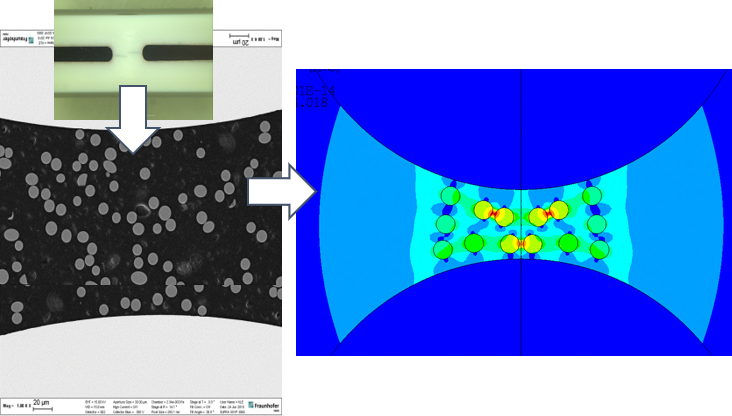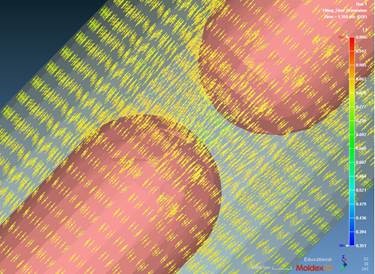Reliable polymer cases for the protection of power electronic components
In a joint research project entitled "PolyLEktronik" Werkzeugbau & Kunststofftechnik Kruse GmbH (WBKT) and the Fraunhofer Institute for Microstructure of Materials and Systems IMWS have set themselves the goal of developing highly reliable polymer cases for power electronics components that are suitable for series production. In particular, they want to focus on the application and linking of various simulation tools in order to realistically consider the diverse physical influences and requirements in the manufacturing process and component operation. In addition, novel testing methods are to be applied and even established into a new testing standard.



If you want to ship glass, you wrap it in foil or foam; the sensitive technology in a computer is enclosed in a metal case: fragile things are protected from external risks by an appropriate cover. This is also the case with power electronics components. These convert electrical energy - for example as power supplies, converters or inverters - and are exposed to extreme stresses depending on the area of application: high voltages, frequent temperature changes, mechanical vibrations, humidity or other influences that promote life-limiting processes. Power electronic components therefore also require special protective cases, which are usually made of plastic. In addition, polymer materials are used for electrical insulation of the components and as carrier and support elements in power electronics components.
The thermomechanical and electrical properties of polymer-based case materials, which are often composed of different components and contain fillers and additives, are crucial for reliable use in cases and, consequently, for the reliable operation of power electronics components. Accordingly, a deep understanding of their properties as a function of the manufacturing process and their impact on subsequent performance in the component is important. "Electronic components are becoming more and more compact, with more and more components being integrated into smaller and smaller spaces. In cars or offshore wind turbines, they are subjected to considerable stresses" says Sandy Klengel, subproject leader and head of the working group "Assessment of Electronic Systems Integration", which has been conducting research in this technology area for many years and addresses this in the "PolyLEktronik" project. "This in turn requires novel solutions for the production as well as the design of the cases and the engineering polymers used in the process," adds Dr. Matthias Zscheyge, who heads the subproject "Research into process and simulation concepts for polymer casings for automotive and power electronics" at Fraunhofer IMWS.
The joint project "PolyLEktronik" therefore aims to develop design, layout and manufacturing concepts for the production as well as for the use of reliable polymer cases for power electronics components. While the family-owned company WBKT focuses on the further development of plastic case components and the associated injection molding tools, Fraunhofer IMWS contributes its expertise in high-resolution microstructure diagnostics and trace element analysis for semiconductor materials as well as in plastics processing and simulation. In sum, new solutions for production-ready and highly reliable case components with polymeric insulation materials for automotive and power electronics are to be created.
The approach here is that both the materials used and the manufacturing tools and processes, as well as the design of the components, already have a detailed view of the later requirements in use and are customized. To this end, simulation tools for the process-related, mechanical as well as electrical design of case components are being researched and applied as part of the project. "Material, process and local microstructure - all these have a significant influence on the subsequent properties of the casing. The holistic view, the possibilities of simulation as well as a broad material database enable a targeted and economic development as well as production of polymer components for power electronics," says Zscheyge. "The deeper understanding of these processes and the transfer into multi-physical simulation tools for a realistic and reliable component design offers enormous potential for increasing the reliability of electronic assemblies with polymer packages," Zscheyge continues. Particular attention is being paid to the influence of local, process-related properties (for example, local fiber orientation as well as filler distribution) on the mechanical and electrical structural properties (such as insulation strength).
The project will investigate the suitability of various polymer case materials such as polyamide (PA) or polyphenylene sulfide (PPS) and the influence of fillers and additives. The interdisciplinary team can use the findings of a previous project to do this. The test method developed in that project is to be further developed so that it can also be used for new materials and material combinations. It has a major advantage over previous test methods, which examine plate-shaped test specimens, which is often not practical: the new method, which is based on a further developed test specimen geometry, can be used to map application-related operating conditions such as the influence of an ambient medium, so that statements can be made about the degradation behavior and aging mechanisms of polymers under the influence of humidity and temperature on important properties such as dielectric strength.
"With our high-resolution instruments and methods, we can track how diffusion and migration processes occur in the complex polymer materials and how they are affected by varying environmental conditions and electric fields" says Klengel. The plan is to develop the novel test approach for determining dielectric strength to such an extent in the project that it will subsequently be possible to establish it as a new standard as part of a DIN/ENC/CEN certification.